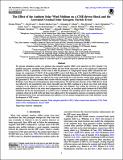Por favor, use este identificador para citar o enlazar a este item:
http://hdl.handle.net/10261/337504COMPARTIR / EXPORTAR:
 SHARE SHARE
 CORE
BASE CORE
BASE
|
|
| Visualizar otros formatos: MARC | Dublin Core | RDF | ORE | MODS | METS | DIDL | DATACITE | |

| Título: | The effect of the ambient solar wind medium on a CME-driven shock and the associated gradual solar energetic particle event |
Autor: | Wijsen, Nicolas; Lario, David; Sánchez-Cano, Beatriz; Jebaraj, Immanuel C.; Dresing, Nina; Richardson, Ian; Aran, Angels; Kouloumvakos, Athanasios; Ding, Zhejie; Niemela, Antonio; Palmerio, Erika; Carcaboso, Fernando; Vainio, Rami; Afanasiev, Alexandr; Pinto, Marco; Pacheco, Daniel; Poedts, Stefaan; Heyner, Daniel | Fecha de publicación: | 2023 | Editor: | IOP Publishing | Citación: | Astrophysical Journal 950(2): 172 (2023) | Resumen: | We present simulation results of a gradual solar energetic particle (SEP) event detected on 2021 October 9 by multiple spacecraft, including BepiColombo (Bepi) and near-Earth spacecraft such as the Advanced Composition Explorer (ACE). A peculiarity of this event is that the presence of a high-speed stream (HSS) affected the low-energy ion component (≲5 MeV) of the gradual SEP event at both Bepi and ACE, despite the HSS having only a modest solar wind speed increase. Using the EUHFORIA (European Heliospheric FORecasting Information Asset) magnetohydrodynamic model, we replicate the solar wind during the event and the coronal mass ejection (CME) that generated it. We then combine these results with the energetic particle transport model PARADISE (PArticle Radiation Asset Directed at Interplanetary Space Exploration). We find that the structure of the CME-driven shock was affected by the nonuniform solar wind, especially near the HSS, resulting in a shock wave front with strong variations in its properties such as its compression ratio and obliquity. By scaling the emission of energetic particles from the shock to the solar wind compression at the shock, an excellent match between the PARADISE simulation and in situ measurements of ≲5 MeV ions is obtained. Our modeling shows that the intricate intensity variations observed at both ACE and Bepi were influenced by the nonuniform emission of energetic particles from the deformed shock wave and demonstrates the influence of even modest background solar wind structures on the development of SEP events. | Versión del editor: | https://doi.org/10.3847/1538-4357/acd1ed | URI: | http://hdl.handle.net/10261/337504 | DOI: | 10.3847/1538-4357/acd1ed | E-ISSN: | 1538-4357 |
| Aparece en las colecciones: | (ICE) Artículos |
Ficheros en este ítem:
| Fichero | Descripción | Tamaño | Formato | |
|---|---|---|---|---|
| effectevent.pdf | 2,32 MB | Adobe PDF |  Visualizar/Abrir |
CORE Recommender
SCOPUSTM
Citations
7
checked on 29-abr-2024
WEB OF SCIENCETM
Citations
2
checked on 25-feb-2024
Page view(s)
27
checked on 30-abr-2024
Download(s)
13
checked on 30-abr-2024
Google ScholarTM
Check
Altmetric
Altmetric
Este item está licenciado bajo una Licencia Creative Commons

